IDEX Online Research: Jewelry Supplier Price Inflation Cools MoM, But Up Double-Digit YoY
May 24, 11
(IDEX Online) - Jewelry supplier prices rose by a robust 11.7% in April from the same month a year ago. On a month-to-month basis, supplier jewelry price inflation declined by a very modest 0.7%, the first monthly pause in about a year.
Monthly swings are less meaningful, but may give an indication of the strength – or weakness – of the underlying factors that affect jewelry suppliers’ prices.
April’s jewelry supplier price inflation rate of 11.7% was substantially above the average jewelry supplier inflation rate of 9.3% for the full year 2010, and it was multiples above 2009’s supplier inflation rate of 3.3%.
The graph below summarizes year-over-year jewelry supplier price inflation on a monthly basis.
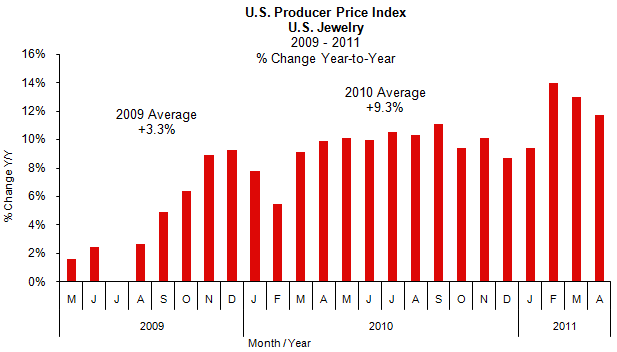 Source: BLS |
Higher Precious Metal Prices Drove April Inflation Pace
Jewelry suppliers’ prices of precious metals jewelry rose by 11.7% during April 2011 versus the same month a year ago. This was in line with jewelry suppliers’ overall inflation rate for all jewelry and watches of 11.7% for the month, and it was down notably from the prior month’s +14.6% and February’s +16.5%.
On a month-over-month basis, jewelry suppliers’ prices for precious metal jewelry reflected deflation of 2.3% for April 2011 versus March 2011. On an annualized basis, this would suggest that suppliers’ jewelry prices could decline by more than 25%. This is very unrealistic, and illustrates the danger of trying to annualize monthly inflation swings. However, it does suggest that the underlying factors affecting suppliers’ costs may be softening.
The graph below compares the jewelry supplier inflation rate for precious metals jewelry (gold column) versus the overall jewelry supplier inflation rate for jewelry. These comparisons are year-to-year.
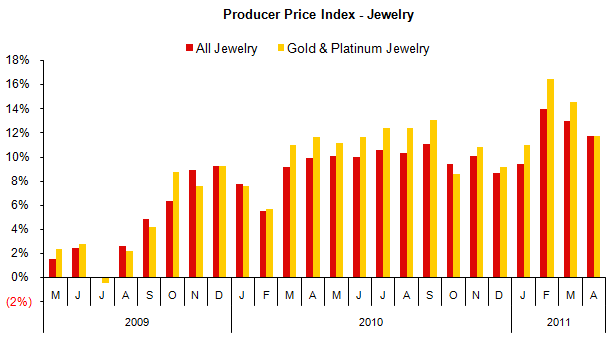 Source: BLS |
Watch Price Inflation Rises At Supplier Level in April
For the second consecutive month, watch prices at the supplier level showed a year-over-year gain – +2.4%. This level of inflation is reminiscent of inflation trends in 2009 and early 2010, when watch prices rose by a low single-digit level at the supplier level. However, in October 2010, watch price inflation suddenly disappeared, on a year-to-year basis, and was nearly non-existent for six months.
On a month-to-month basis, supplier watch prices were up sharply – +2.7%.
The graph below shows year-to-year supplier price inflation for watches for the past twenty-four months. After spiking in early 2009, watch price inflation at the supplier level has steadily declined.
While overall jewelry demand is stronger, watch demand – with the exception of Rolex and a select few other premium brands – remains tepid. Young consumers apparently would rather refer to their mobile phones to get the correct time versus wearing a watch on their wrist.
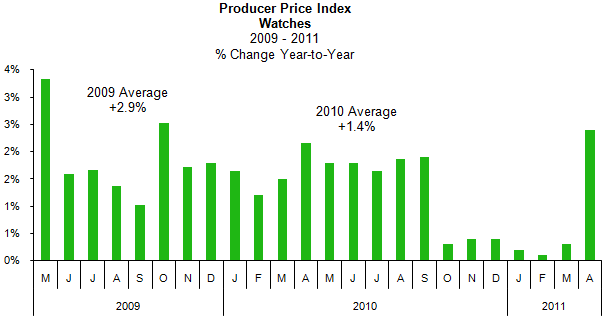 Source: BLS |
Jewelry Retail Prices Show High Single Digit Gains in April 2011
Jewelry retail prices have been climbing steadily since November 2010, driven by both stronger consumer demand and higher supplier prices.
For the month of April 2011, retail jewelry prices – all categories of merchandise – rose by 8.5% over April 2010. This was one of the largest increases in inflation since the summer of 2008, just before the bone-crushing recession hit with full force in the 2008 holiday selling season.
On a month-to-month basis, retail jewelry prices rose by a robust 2.9%, when comparing April 2011 to March 2011. April’s month-to-month price inflation shows that jewelers have continued to hold prices relatively steady since the important Valentine’s Day selling period in February.
The graph below summarizes year-to-year retail jewelry price inflation in the U.S. market.
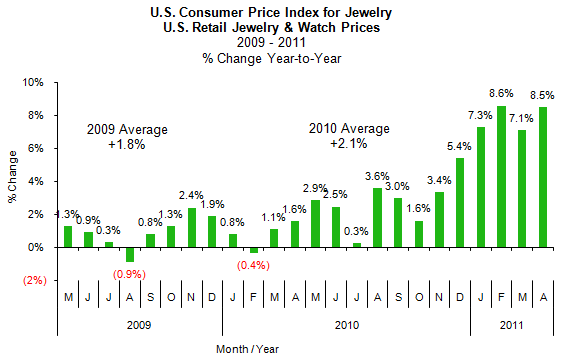 Source: BLS |
Watch Prices Show Increased Inflation
Retail and supplier prices of watches have tended to move together, with prices more or less flattish, both on a month-to-month basis and a year-to-year basis, over the past few years.
Year-over-year, retail watch prices rose by 1.1%. That’s less than last month’s inflation rate of +1.6%, and was well below historic levels. When compared to the prior month March 2011, watch prices in April were down by 0.3%. Both of these figures were well below supplier watch price inflation for the month.
Retail prices of jewelry, excluding watches, rose sharply in April. When compared to April 2010 prices, jewelry retail prices were up by 9.6%, one of the largest gains since mid-year 2008. When compared to March, retail prices of jewelry rose by a strong 3.3%.
The graph below compares the inflation rate for jewelry and watches (green bars), jewelry only (red bars), and watches (gold bars).
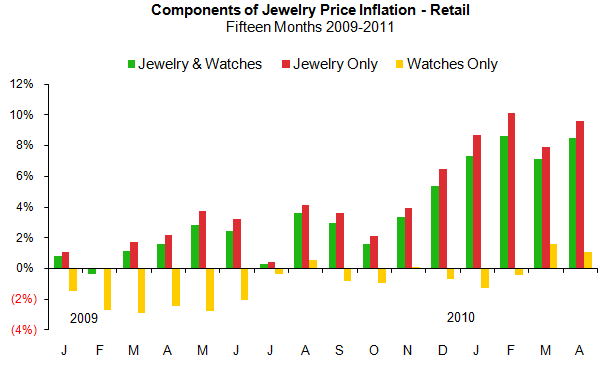
Source: BLS
Components of Inflation Suggest Prices Will Rise
This month, we are introducing new, highly detailed graphs, which illustrate the underlying trends of factors, which affect jewelry prices, both at retail and at the supplier level. In April, virtually all of these factors suggested that jewelry price inflation is here to stay.
Currency Trends – Negative for the Jewelry Industry
The U.S. dollar is weaker against the Euro.
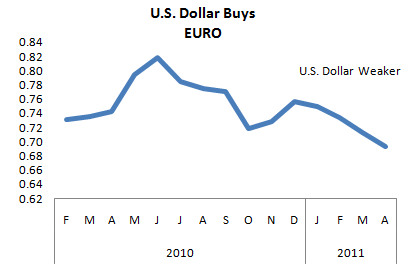 |
The U.S. dollar is weaker against the Indian Rupee.
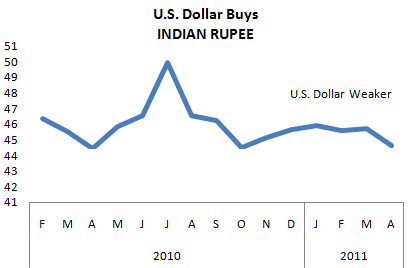 |
The U.S. dollar is weaker against the Thai Baht.
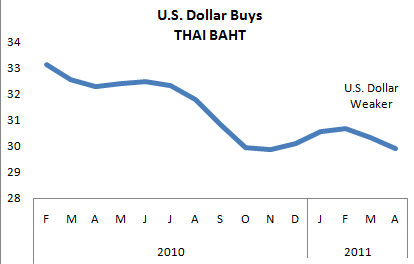 |
The U.S. dollar is weaker against the South African Rand.
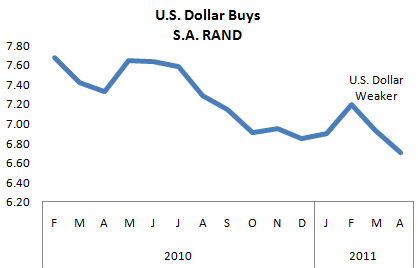 |
The U.S. dollar is weaker against the Chinese Yuan.
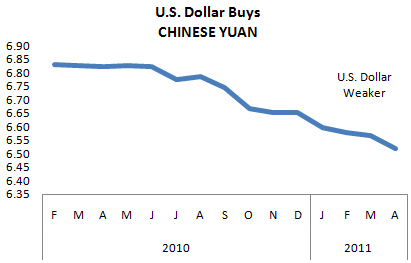 |
Jewelry Commodity Costs Are Generally Higher
Polished diamond prices are rising sharply, gold prices continue to rise, silver prices are up sharply and platinum prices are rising moderately.
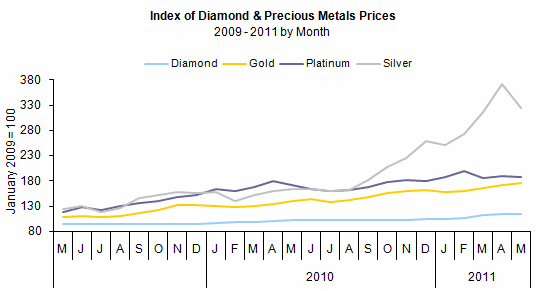 Source: IDEX Online & Kitco |
The table below provides a detailed summary of the factors affecting jewelry price inflation throughout the distribution pipeline.
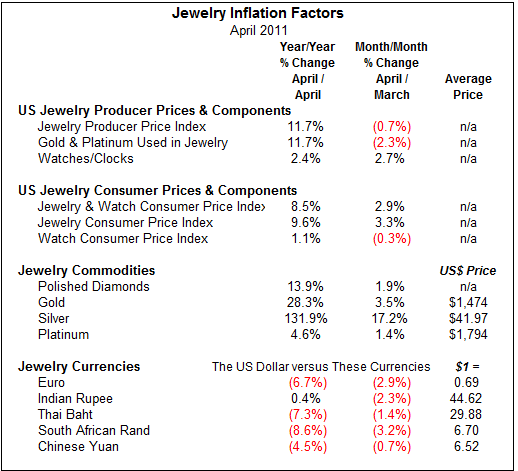 Source: Various markets |